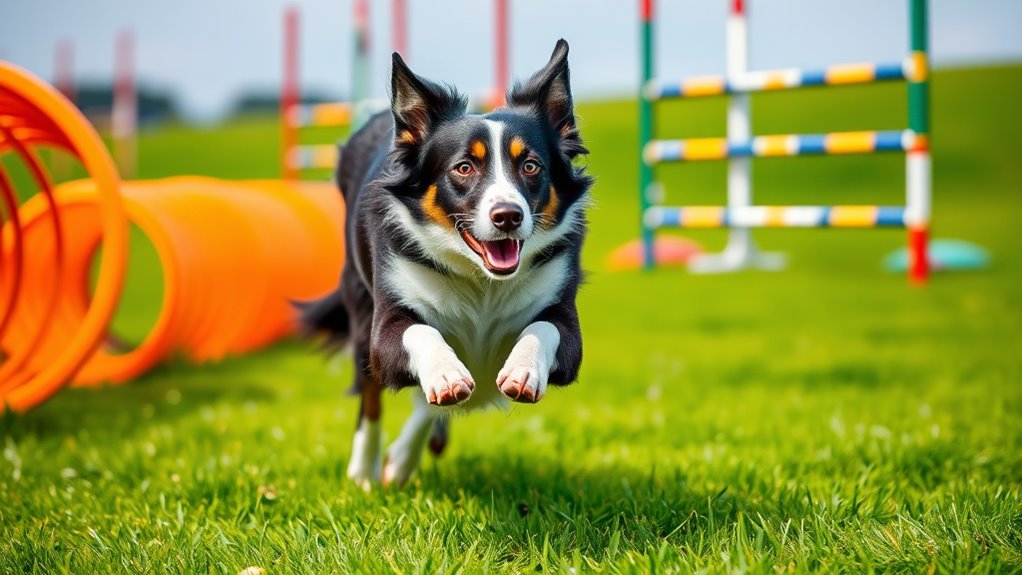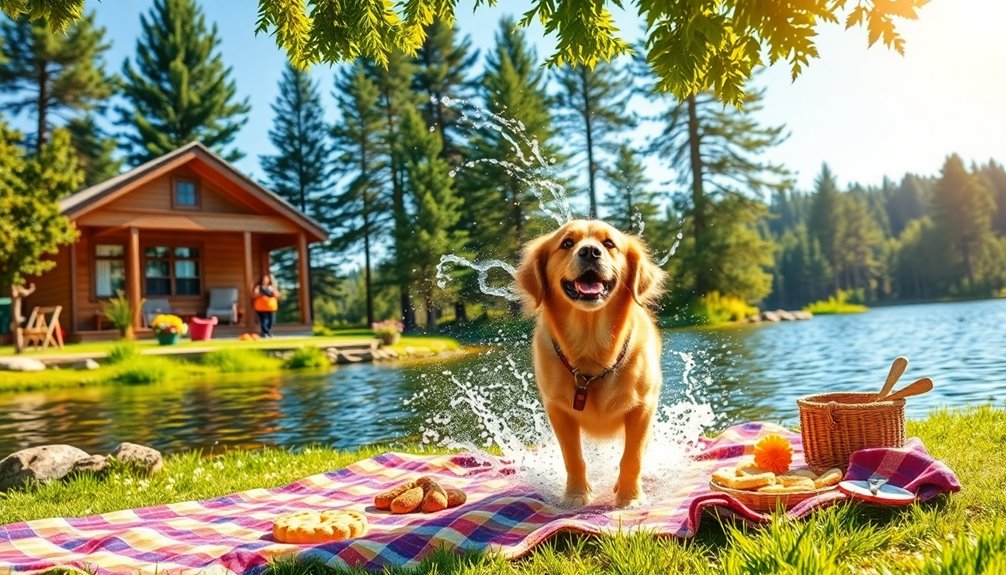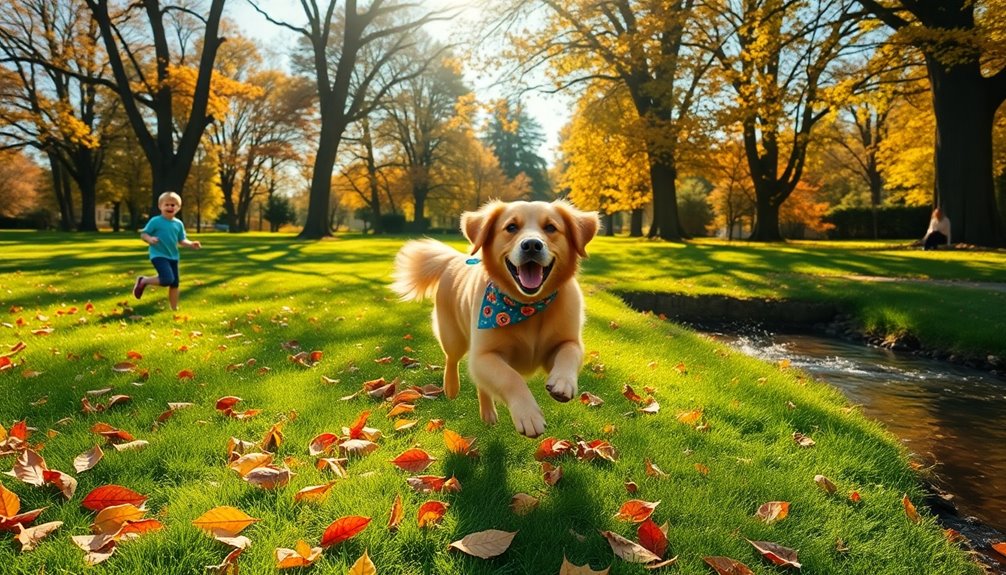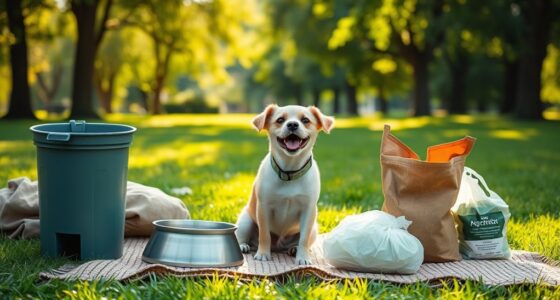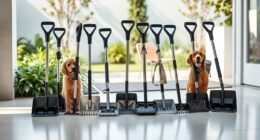Agility can be a great fit if your dog is active, enthusiastic, and enjoys learning new skills. It promotes physical coordination, mental sharpness, and confidence while strengthening your bond. Start with basic commands and safe equipment, gradually increasing difficulty as your dog gains confidence. Keep training sessions fun, short, and positive to maintain enthusiasm. If you keep exploring, you’ll discover how to guarantee agility is safe and enjoyable for your dog.
Key Takeaways
- Agility enhances physical fitness, coordination, and mental sharpness, making it suitable for active, motivated dogs.
- It requires training patience, consistency, and positive reinforcement tailored to your dog’s learning pace.
- Proper equipment and safety measures are essential for building confidence and preventing injuries.
- Suitable for dogs of various breeds and ages if introduced gradually and with appropriate difficulty levels.
- Agility strengthens the bond between owner and dog through shared achievement and engaging activities.
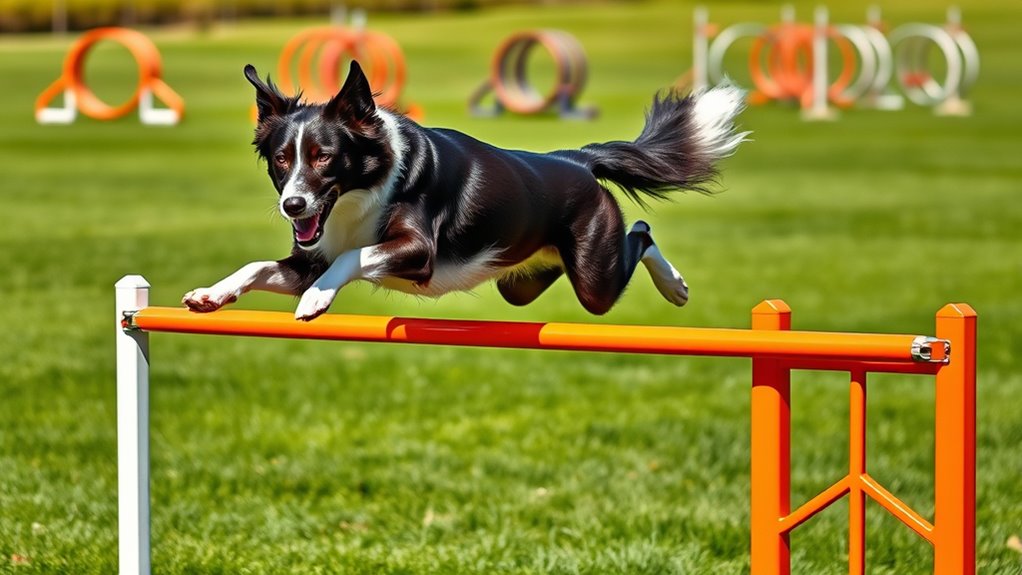
Have you ever wondered how dogs channel their energy and agility into exciting activities? If you’re considering agility as an option, understanding the training techniques and equipment selection is essential. Agility training isn’t just about having a fast dog; it’s about teaching your dog to navigate obstacle courses confidently and safely. You’ll need to develop effective training techniques that focus on building your dog’s skills gradually, reinforcing positive behaviors, and maintaining motivation. Consistency is key—start with simple commands and low-stress environments, then progressively introduce more complex obstacles. Using treats, praise, and play can help keep your dog engaged and eager to learn. Remember, patience matters; every dog learns at its own pace, so adjust your training methods accordingly. Incorporating self-understanding into your training approach can also enhance communication and responsiveness between you and your dog. When it comes to equipment selection, choosing the right gear is vital for your dog’s safety and success. Start with well-made, adjustable obstacles that fit your dog’s size and skill level. Common equipment includes tunnels, weave poles, jumps, and seesaws, all designed to challenge your dog’s agility while minimizing risk. Make sure the surfaces are non-slip to prevent injuries, and regularly inspect the equipment for wear and tear. Using proper equipment also helps your dog develop confidence, as they can safely practice each obstacle repeatedly. Incorporate equipment into your training sessions gradually, allowing your dog to become familiar with each piece before combining them into full courses. As you progress, remember that training techniques should be fun and rewarding. Keep sessions short and lively to maintain your dog’s interest. Incorporate plenty of encouragement and rewards to reinforce good performance. Also, consider the importance of gradually increasing difficulty, rather than rushing through obstacles, so your dog learns to approach each challenge calmly and confidently. Proper equipment selection supports this process, providing a safe and stimulating environment for your dog to learn and excel. Over time, your dog will develop not only agility and coordination but also a stronger bond with you through shared accomplishment. With patience, consistent training techniques, and the right equipment, agility can become a rewarding activity that boosts your dog’s physical health and mental sharpness. Whether you’re just starting out or looking to refine your skills, taking a thoughtful approach will help your dog thrive and enjoy every moment on the course.
Frequently Asked Questions
What Age Is Best to Start Agility Training With My Dog?
You might wonder when the best age is to start agility training. Generally, puppies around 12-18 months are ideal, as they’re physically developed and can handle training methods safely. Always prioritize safety considerations, gradually introducing obstacles and avoiding overexertion. Early socialization and basic commands build a strong foundation. Keep sessions fun and positive, and consult your vet to ensure your dog’s prepared for more advanced agility activities.
Are Certain Breeds Naturally Better Suited for Agility Sports?
Certain breeds are naturally better suited for agility sports due to breed suitability, like Border Collies or Jack Russell Terriers, which excel in speed and agility. However, you should consider your dog’s individual personality and training challenges, as some breeds may require more patience and specialized training. Ultimately, any breed can succeed with proper training, but choosing a breed with the right traits can make agility more enjoyable and rewarding for both of you.
How Do I Find a Qualified Agility Trainer or Club Nearby?
Did you know that over 80% of successful agility competitors train with certified trainers? To find a qualified agility trainer or club nearby, start by searching online directories and local pet stores. Look for trainers with proper certification and verify the club meets membership requirements. Visiting potential clubs or trainers allows you to observe their methods and ask about their experience, helping you choose the best fit for your dog.
What Equipment Is Needed to Set up an Agility Course at Home?
To set up a home agility course, you’ll need basic training obstacles like jumps, tunnels, and weave poles. Make certain to include safety gear such as non-slip mats and padded barriers to protect your dog. Start with simple equipment and gradually add more complex pieces as your dog gains confidence. Always supervise your dog during training to prevent injuries and ensure a positive, safe experience.
How Can I Tell if My Dog Enjoys Agility Activities?
You can tell if your dog enjoys agility activities by observing their body language and enthusiasm during training. Look for signs like wagging tail, focused eyes, and a willingness to engage. If your dog seems relaxed and enthusiastic, they probably enjoy it. Remember, training patience is essential; positive reinforcement helps your dog associate agility with fun. If they hesitate or show stress, take a break and reassess their comfort level.
Conclusion
So, giving agility a try might just be the gentle nudge your dog needs to discover new joys and talents. It’s a wonderful way to bond and keep them happily busy, all while gently encouraging their natural abilities. Whether your pup takes to it like a fish to water or simply enjoys the playful journey, you’re both set to enjoy some delightful moments together. Embrace the adventure—your dog’s best days might be just around the corner.

